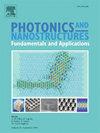Mid-infrared band multi-Fano resonance-based sensing of high-Q concave-convex arrays of metasurface with full control of Fano spectral profile
IF 2.9
3区 物理与天体物理
Q3 MATERIALS SCIENCE, MULTIDISCIPLINARY
Photonics and Nanostructures-Fundamentals and Applications
Pub Date : 2025-05-11
DOI:10.1016/j.photonics.2025.101398
引用次数: 0
Abstract
In this study, a concave-convex array metasurface with a height difference characterized structure is proposed, combining in-plane and out-of-plane asymmetry to achieve a high Q-factor, refractive index sensing, and full control of the Fano spectral profile. Notably, both the concave model and the convex model, can only produce one Fano peak. But it can yield multiple Fano resonance peaks in the mid-infrared band following a simple combination. Herein, we have performed both near-field and far-field analysis for each Fano resonance generation. The designed metasurface achieves a remarkably high Q-factor of 9.63637 × 105. Moreover, it exhibits excellent reflection resonances under different polarization directions. In terms of refractive index sensing, the designed metasurface attains a sensitivity of 600 nm/RIU under TE polarization, while under TM polarization, it achieves full control of the Fano spectral profile by changing the incidence angle. The integration of periodic arrays with height differences in metasurfaces shows tremendous potential in controlling the Fano spectral profile and enhancing sensing capabilities. Additionally, this study will provide new inspirations for the sensing metasurface design with high optical performance.
基于中红外波段多范诺共振的超表面高q凹凸阵列全控制范诺谱线传感
本研究提出了一种具有高差特征结构的凹凸阵列超表面,结合面内和面外不对称,实现了高q因子、折射率传感和Fano光谱轮廓的完全控制。值得注意的是,无论是凹模型还是凸模型,都只能产生一个Fano峰。但在简单的组合后,它可以在中红外波段产生多个范诺共振峰。在这里,我们对每个范诺共振产生进行了近场和远场分析。所设计的超表面达到了9.63637 × 105的高q因子。在不同偏振方向下,均表现出优异的反射共振特性。在折射率传感方面,设计的超表面在TE偏振下的灵敏度达到600 nm/RIU,而在TM偏振下,通过改变入射角实现对Fano光谱轮廓的完全控制。在超表面上集成具有高差的周期阵列在控制Fano光谱轮廓和增强传感能力方面具有巨大的潜力。此外,该研究将为高光学性能的传感超表面设计提供新的灵感。
本文章由计算机程序翻译,如有差异,请以英文原文为准。
求助全文
约1分钟内获得全文
求助全文
来源期刊
CiteScore
5.00
自引率
3.70%
发文量
77
审稿时长
62 days
期刊介绍:
This journal establishes a dedicated channel for physicists, material scientists, chemists, engineers and computer scientists who are interested in photonics and nanostructures, and especially in research related to photonic crystals, photonic band gaps and metamaterials. The Journal sheds light on the latest developments in this growing field of science that will see the emergence of faster telecommunications and ultimately computers that use light instead of electrons to connect components.

 求助内容:
求助内容: 应助结果提醒方式:
应助结果提醒方式:


